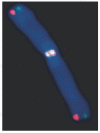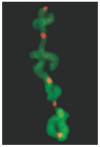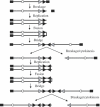Telomeres, chromosome instability and cancer
- PMID: 16682448
- PMCID: PMC1458522
- DOI: 10.1093/nar/gkl303
Telomeres, chromosome instability and cancer
Abstract
Telomeres are composed of repetitive G-rich sequence and an abundance of associated proteins that together form a dynamic cap that protects chromosome ends and allows them to be distinguished from deleterious DSBs. Telomere-associated proteins also function to regulate telomerase, the ribonucleoprtotein responsible for addition of the species-specific terminal repeat sequence. Loss of telomere function is an important mechanism for the chromosome instability commonly found in cancer. Dysfunctional telomeres can result either from alterations in the telomere-associated proteins required for end-capping function, or from alterations that promote the gradual or sudden loss of sufficient repeat sequence necessary to maintain proper telomere structure. Regardless of the mechanism, loss of telomere function can result in sister chromatid fusion and prolonged breakage/fusion/bridge (B/F/B) cycles, leading to extensive DNA amplification and large terminal deletions. B/F/B cycles terminate primarily when the unstable chromosome acquires a new telomere, most often by translocation of the ends of other chromosomes, thereby providing a mechanism for transfer of instability from one chromosome to another. Thus, the loss of a single telomere can result in on-going instability, affect multiple chromosomes, and generate many of the types of rearrangements commonly associated with human cancer.
Figures



References
-
- Muller H.J. The remaking of chromosomes. The collecting net-Woods Hole. 1938;13:181–198.
-
- Cornforth M.N., Meyne J., Littlefield L.G., Bailey S.M., Moyzis R.K. Telomere staining of human chromosomes and the mechanism of radiation-induced dicentric formation. Radiat Res. 1989;120:205–212. - PubMed
Publication types
MeSH terms
Grants and funding
LinkOut - more resources
Full Text Sources
Other Literature Sources
Miscellaneous

